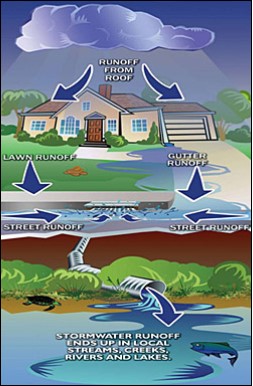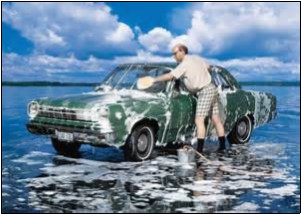Stormwater Management
What is Stormwater?
Stormwater in Southwest Louisiana is generally water resulting from rain that runs off surfaces such as rooftops, paved streets, highways and parking lots. Along the way, the water may pick up and transport contaminants including motor oils, gasoline, antifreeze, and brake dust (commonly found on pavements), fertilizers and pesticides (found on landscaped areas), and soil sediments (from farms and construction sites). The water eventually flows into a local stream, river or lake, or into a storm drain and continues through storm pipes until it is released untreated into a local water body.
During the construction process, soil is the most vulnerable to erosion by wind and water. This eroded soil endangers water resources by reducing water quality, and causing the siltation of aquatic habitat for fish and other desirable species. Eroded soil also necessitates repair of sewers and ditches, and the dredging of lakes. In addition, clearing and grading during construction causes the loss of native vegetation necessary for terrestrial and aquatic habitat, and may be necessary to provide a healthy living environment for citizens of Lake Charles, as well as our neighbors.
|
The intent of the Stormwater Management is to:
Minimize water pollution by providing guidance on how to protect storm drain inlets and waterways during construction activities from grading, utility construction, millings/grinding operations, concrete saw water, waste materials such as concrete washout, and any disturbances to dirt/earth. Protect as much existing vegetation as possible, slow down runoff, prevent or minimize erosion from construction activities, provide incremental phased seeding and mulching, avoidance and minimization, stabilization, implementation, seeding and scheduling of the plan. Stabilize earth disturbances; prevent sediment from reaching the receiving or surface waters.
|
 |
|
 |


Related Pages
- 2024 LC Launch Calendar of Events
- LC Create Contest Announced as part of LC Launch Small Business Week Events
- 2024 Community Connection
- Light up the Lake 2023
- Millennium Park Holiday Hours
- Historic City Hall Holiday Events
- Light Up the Lake 2022
- Mayor Hunter Swearing-In Address 2021
- Guidelines for Reopening Mallard Cove
Upcoming Events
- City Council MeetingJanuary 07 5:30 pm - 11:59 pm
- Groove with the City - Swing Out Dance LessonsJanuary 08 5:30 pm - 7:30 pm
- Rollin' Into the New Year Skate NightJanuary 10 4:00 pm - 8:00 pm
- City Council Agenda MeetingJanuary 13 5:30 pm - 11:59 pm
- Groove with the City: Zydeco Dance LessonsJanuary 13 5:30 pm - 7:30 pm